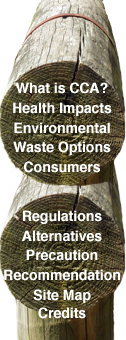Waste Options
Introduction
![]() Dangers
of Landfill Disposal
Dangers
of Landfill Disposal
![]() CCA-Treated
Timber a Hazardous Waste
CCA-Treated
Timber a Hazardous Waste
![]() Disposal
in Australia
Disposal
in Australia
![]() References
References
The eventual disposal of CCA-treated timber is of great concern to many stakeholders, due to the volume of anticipated waste and the lack of safe disposal options, given the toxicity of the treated timber. If CCA-treated timber is burned the smoke and the ash can be toxic (APVMA, 2003: 6), so it is usually disposed of in municipal landfills where it continues to leach arsenic. In the US, material that leaches arsenic is classified as a hazardous waste and cannot be disposed of in municipal landfills. However, CCA-treated timber has been granted an exemption (Sharp & Walker, 2001: 11).
According to academics at the University of Florida, the exemption in the US was due to CCA involving pentavalent arsenic—a less toxic species of arsenic—and the presumption that the leaching mainly occurred with newly-treated timber. However, recent research on timber weathered for over ten years has found that the pentavalent arsenic is somehow converting to the ‘highly toxic’ trivalent arsenic, in volumes well over the limit for non-hazardous waste. In addition, it is surmised that as the timber’s lignin decomposes, large quantities of arsenic are released from the older wood (Fauteux, 2003). Another study in the Journal of Hazardous Wastes has found that arsenic leaching from CCA-treated timber waste disposed of in landfills “is a major concern from a disposal point of view with respect to ground water quality” (Townsend, 2004).
CCA-Treated Timber a Hazardous Waste
Similarly, in the UK the requirements for safe disposal of hazardous waste now also apply to waste CCA-treated timber so as to prevent air and other polluting emissions (DEFRA, 2003). In Europe discarded CCA-treated timber has been classified as a hazardous waste since 2000 (Commission of the European Communities, 2003: 9). This was after the CSTEE raised concerns about the disposal of treated-timber in landfills: ‘The CSTEE wishes to underline that a major source of concern regarding the use of arsenic-containing wood preservatives relates to the high degree of uncertainty regarding the speciation of arsenic during its long-term storage in landfills (the major points of arsenic accumulation), making reliable quantitative predictions about its migration and bioavailability extremely difficult. This is a serious knowledge gap which the CSTEE recommends should be addressed by further research. In the meantime, it would be advisable to exercise caution by limiting the use of arsenic-based wood preservation to those situations where it is absolutely necessary’ (CSTEE 1998).
In Australia, CCA-treated timber waste is not classified as hazardous waste and there is a lack of clear information about how this waste should be disposed. Currently, CCA-treated timber is accepted at the discretion of the landfill operator in NSW, South Australia and Victoria (Smith and Mollah, 2004) and is often collected with other municipal waste. In NSW, CCA-treated timber is a priority waste (although a priority 2 waste rather than a priority 1 waste) on the Extended Producer Responsibility list but it is still accepted at a number of municipal landfill locations (Mitchell, S., NSW Department of Environment and Conservation, Pers. Comm., 15/11/04). In Victoria, “product stewardship agreements on waste avoidance and recovery” will not be established for treated timber till 2009/10 (Ecocycle Victoria, 2003: 17).
Waste Services NSW, which operates 4 landfills and 7 transfer stations, could not provide adequate advice on the customer information line to this researcher as to whether treated timber is a hazardous waste and whether it could be disposed of at any of its four landfill sites (Waste Services NSW, Customer Enquiries, Pers. Comm., 15/11/04). However the Waste Services website stated that no treated timbers would be accepted by Waste Services, as timber waste was reused for chipping for landscape mulches and as biofuel (Waste Services NSW, 2004).
APVMA (2003) Arsenic Timber Treatments (CCA and Arsenic Trioxide): Review Scope Document. Canberra: Australian Pesticides and Veterinary Medicines Authority, Canberra, March. (pdf - 160kb)
Commission of the European Communities (2003), ‘Commission Directive 2003/2/Ec of 6 January 2003 Relating to Restrictions on the Marketing and Use of Arsenic.' Official Journal of the European Communities L (4). 9 January.
CSTEE (Scientific Committee on Toxicity, Ecotoxicity and the Environment) (1998), ‘Opinion on the Report by WS Atkins International Ltd (Vol. B) "Assessment of the Risks to Health and to the Environment of Arsenic in Wood Preservatives and of the Effects of Further Restrictions on Its Marketing and Use" Expressed at the 5th CSTEE Plenary Meeting.’ Brussels: European Commission (EC). 15 September.
DEFRA (2003), Consultation on the transposition of the 10th adaptation to technical progress of Annex I to Council Directive 76/769/EEC relating to restrictions on the marketing and use of arsenic in England, Scotland and Wales (Great Britain), August, Department for Environment, Food and Rural Affairs, Great Britain.
Ecocycle Victoria (2003), ‘Towards Zero Waste: A Solid Industrial Waste Management Plan for Victoria’, Draft, March (pdf).
Fauteux, A. (2003), ‘Treated wood more toxic as it ages’, La Presse, Montreal, May 17. p.A8.
Sharp, R. and Walker, B. (2001), Poisoned Playgrounds: Arsenic in 'Pressure-Treated' Wood, Environmental Working Group and Healthy Building Network, Washington D.C. http://www.ewg.org/reports/poisonedplaygrounds
Smith, T. And Mollah, M. (2004), ‘CCA Review Implications For Viticulture’, The Australian & New Zealand Grapegrower And Winemaker, Ryan Publications, April.
Townsend, T., Tolaymat, T., Solo-Gabriele, H., Dubey, B., Stook, K., and Wadanambi, L., (2004), ‘Leaching of CCA-treated wood: implications for waste disposal’, Journal of Hazardous Materials 114(1-3): 75-91.
Waste Services NSW (2004), Waste Services website, http://www.wasteservice.nsw.gov.au (accessed 15/11/04).


